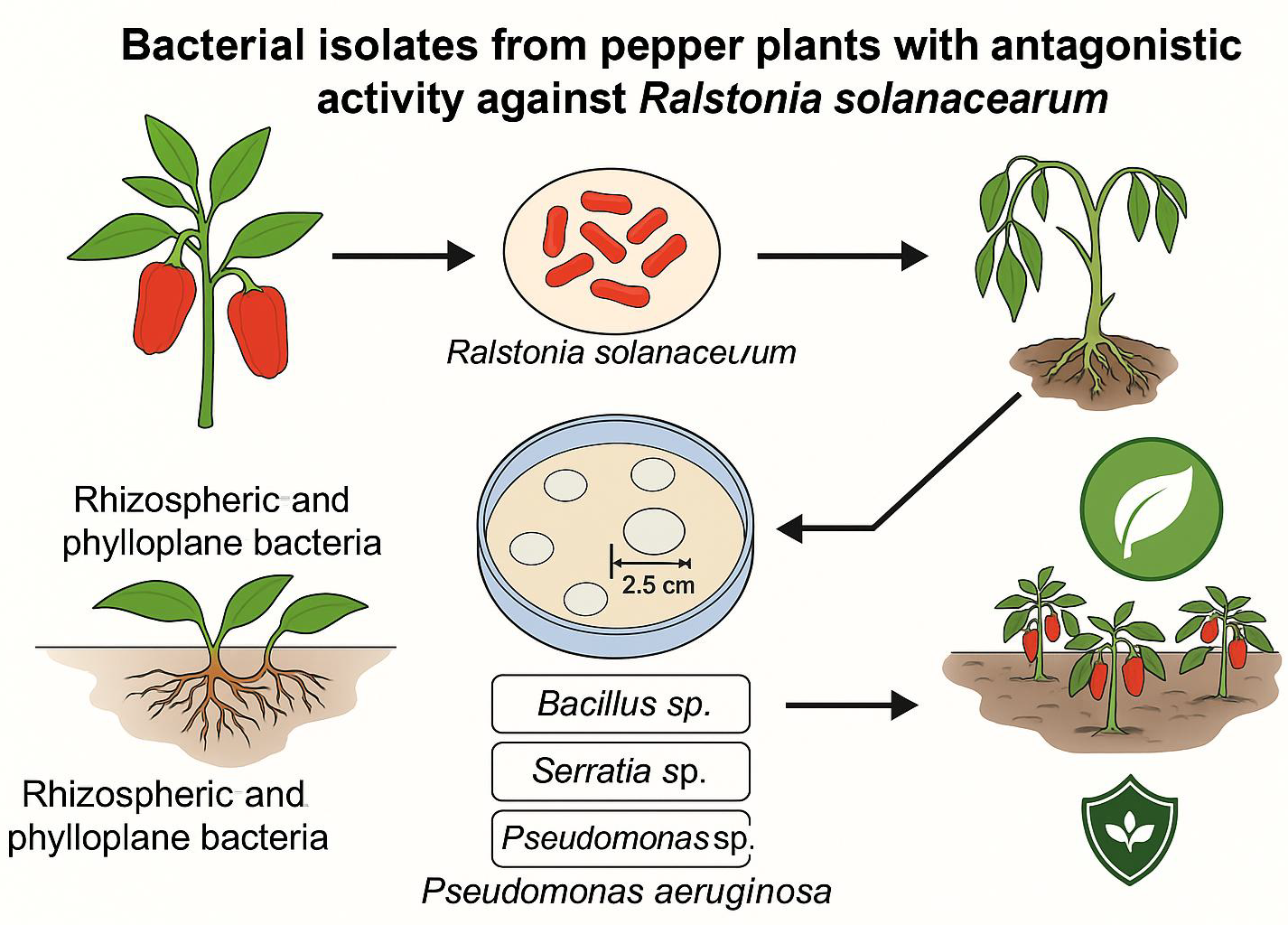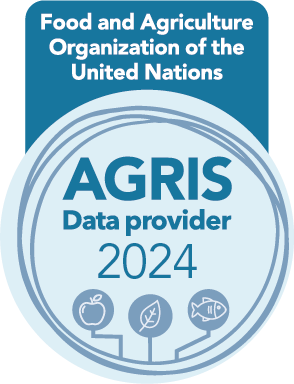Rhizospheric and phylloplane bacteria from Capsicum annuum: Uncovering candidates for biocontrol of Ralstonia solanacearum
DOI:
https://doi.org/10.17268/sci.agropecu.2025.042Palabras clave:
Ralstonia solanacearum, biocontrol, Pseudomonas, halo, inhibitionResumen
Ralstonia solanacearum, the causative agent of bacterial wilt, is a major plant pathogen affecting many economically significant crops, including pepper (Capsicum annuum). This pathogen causes severe yield losses due to the limited effectiveness of current control measures. This study aimed to evaluate potential biocontrol agents for managing Ralstonia solanacearum by isolating and testing microorganisms from the rhizosphere and phylloplane of pepper plants. A total of 32 bacterial isolates were screened, and four strains showed the most pronounced antagonistic activity in vitro, producing inhibition zones ranging from 4.0 to 6.12 cm. The most effective isolates included three rhizospheric strains identified as Bacillus sp., Serratia sp., and Pseudomonas sp., and one phylloplane strain identified as Pseudomonas aeruginosa. These microorganisms effectively suppressed Ralstonia solanacearum growth under laboratory conditions and show strong potential as biocontrol agents for bacterial wilt in pepper crops.
Citas
Alamer, A. I. S., Tomah, A. A., Li, B., & Zhang, J.-Z. (2020). Isolation, identification and characterization of rhizobacteria strains for biological control of bacterial wilt (Ralstonia solanacearum) of eggplant in China. Agriculture, 10(2), 37. https://doi.org/10.3390/agriculture10020037
Abdelsalam, N. R., Alghamdi, A. I., & El-Saadony, M. T. (2023). Plant growth-promoting rhizobacteria (PGPR) as sustainable agents for biocontrol of plant diseases: Advances and challenges. Microorganisms, 11(4), 1056. https://doi.org/10.3390/microorganisms11041056
El-Sersawy, M. M., Hassan, S. E., El-Ghamry, A. A., El-Gwad, A. M. A., & Fouda, A. (2021). Implication of plant growth-promoting rhizobacteria of Bacillus spp. as biocontrol agents against wilt disease caused by Fusarium oxysporum Schlecht. in Vicia faba L. Biomolecular concepts, 12(1), 197–214. https://doi.org/10.1515/bmc-2021-0020
Etesami, H., Ryong Jeong, B., & Glick, B. R. (2023). Biocontrol of plant diseases by Bacillus spp. Physiological and Molecular Plant Pathology, 126, 102048. https://doi.org/10.1016/j.pmpp.2023.102048
Gayathiri, E., Bharathi, B., & Priya, K. (2018). Study of the enumeration of twelve clinical important bacterial populations at 0.5 McFarland standard. Int. J. Creat. Res. Thoughts (IJCRT), 6(2), 880–893.
Gavande, S. S., Maurya, A., & Sharma, S. (2024). Isolation and characterization of plant growth promoting rhizobacteria (PGPR) from rhizosphere of major crops grown in Marathwada region of Maharashtra, India. Vegetos, 37, 637–648. https://doi.org/10.1007/s42535-023-00779-y
González-Mendoza, D., Valdés-Rodríguez, O. A., Silva-Rojas, H. V., & Grimaldo-Juarez, O. (2023). Advances in the genetic improvement and stress tolerance of Capsicum spp.: A review. Plants, 12(6), 1257. https://doi.org/10.3390/plants12061257
Goswami, D., Thakker, J. N., & Dhandhukia, P. C. (2016). Portraying mechanics of plant growth promoting rhizobacteria (PGPR): A review. Cogent Food & Agriculture, 2(1), 1127500. https://doi.org/10.1080/23311932.2015.1127500
Holt, J. N., Krieg, P., Sneath, J., Staley, J., & Williams, S. (1994). Bergey's Manual of Systematic Bacteriology. Williams y Wilkins, 786pp.
Kumar, A., Singh, R., & Srivastava, S. (2024). Recent advances in mechanisms of action of PGPR in plant disease suppression. Rhizosphere, 25, 100700. https://doi.org/10.1016/j.rhisph.2024.100700
Kundan, R., Pant, G., Jadon, N., & Kumar, A. (2015). Plant Growth Promoting Rhizobacteria: Mechanism and Current Prospective. J Biofertil Biopestici, 6, 155. https://doi.org/10.4172/2471-2728.1000155
Kurabachew, H., & Wydra, K. (2013). Characterization of plant growth promoting rhizobacteria and their potential as bioprotectant against tomato bacterial wilt caused by Ralstonia solanacearum. Biological Control, 67(1), 75-83. https://doi.org/10.1016/j.biocontrol.2013.07.004
Mahmood, T., Aslam, M., Ahmed, S., & Fatima, R. (2023). Emerging threats to pepper production under changing climate: A review. Scientia Horticulturae, 317, 112011. https://doi.org/10.1016/j.scienta.2023.112011
Mehmood, N., Saeed, M., Zafarullah, S., Hyder, S., Rizvi, Z. F., Gondal, A. S., Jamil, N., Iqbal, R., Ali, B., Ercisli, S., & Kupe, M. (2023). Multifaceted Impacts of Plant-Beneficial Pseudomonas spp. In Managing Various Plant Diseases and Crop Yield Improvement. ACS Omega, 8(25), 22296-22315. https://doi.org/10.1021/acsomega.3c00870
Miljaković, D., Marinković, J., & Balešević-Tubić, S. (2020). The significance of Bacillus spp. in disease suppression and growth promotion of field and vegetable crops. Microorganisms, 8(7), 1037. https://doi.org/10.3390/microorganisms8071037
Moore, L., Kado, C., Bouzar, H., Schaad, N., Jones, J., & Chun, W. (2001). Laboratory Guide for Identification of Plant Pathogenic Bacteria. Edition: 3rd Edn. Publisher: American Phytopathological Society. St Paul, MN.
Musa, Z. U., Hossain, M. T., & Rahman, M. M. (2024). Role of extracellular polysaccharides in virulence and biofilm formation of Ralstonia solanacearum. Microbial Pathogenesis, 186, 106272. https://doi.org/10.1016/j.micpath.2024.106272
Narasimhan, A., & Banerjee, K. (2021). Isolation and characterization of phylloplane bacteria from papaya plant for the biocontrol of post-harvest diseases in papaya. International Journal of Environment, Agriculture and Biotechnology, 6(1), 307-315. https://doi.org/10.22161/ijeab.61.38
Rehman, R. U., Naz, S., & Abbas, T. (2022). Nutritional and phytochemical profile of Capsicum annuum: A review. Journal of Food Science and Technology, 59(5), 1885–1895. https://doi.org/10.1007/s13197-021-05277-4
Rico-Jiménez, M., Muñoz, S., Lomas, C., Krell, T., & Matilla, M. (2023). Regulation of indole-3-acetic acid biosynthesis and consequences of auxin production deficiency in Serratia plymuthica. Microbial Biotechnology, 16, 1671–1689. https://doi.org/10.1111/1751-7915.14296
Rose, A. (1975). Growth and handling of yeast. Chapter 1 In: Prescott, D. M. (ed.), Methods in Cell Biology, 12, Pages 1-16.
Sánchez-Montesinos, B., Solano, J., & Aranda, E. (2023). Plant–microbe interactions and their role in sustainable agriculture: A case study of rhizosphere microbiomes. Plants, 12(2), 394. https://doi.org/10.3390/plants120203941-16.
Tahir, H. A. S., Gu, Q., Wu, H., Raza, W., Safdar, A., Huang, Z., Rajer, F. U., & Gao, X. (2017). Effect of volatile compounds produced by Ralstonia solanacearum on plant growth promoting and systemic resistance inducing potential of Bacillus volatiles. BMC Plant Biology, 17(1), 133. https://doi.org/10.1186/s12870-017-1083-6
Yang, S., Shi, Y., Zou, L., Huang, J., Shen, L., Wang, Y., Guan, D., & He, S. (2020). Pepper CaMLO6 Negatively Regulates Ralstonia solanacearum Resistance and Positively Regulates High Temperature and High Humidity Responses. Plant and Cell Physiology, 61(7), 1223-1238. https://doi.org/10.1093/pcp/pcaa052
Zhao, H., Su, H., Sun, J., Dong, H., & Mao, X. (2024). Bioconversion of α-Chitin by a Lytic Polysaccharide Monooxygenase OsLPMO10A Coupled with Chitinases and the Synergistic Mechanism Analysis. J. Agric. Food Chem., 72(13), 7256–7265. https://pubs.acs.org/doi/10.1021/acs.jafc.3c08688
Zhang, Y., Li, H., Zhao, H., & Wang, J. (2023a). Morphological and molecular identification of Ralstonia solanacearum strains from tomato and pepper plants in southern China. Plant Pathology Journal, 39(1), 55–63. https://doi.org/10.5423/PPJ.OA.09.2022.0149
Zhang, X., Wu, D., & Wang, Y. (2023b). Rhizobacteria-mediated biocontrol of soil-borne pathogens: A sustainable approach to crop protection. Frontiers in Plant Science, 14, 1164203. https://doi.org/10.3389/fpls.2023.1164203

Descargas
Publicado
Cómo citar
Número
Sección
Licencia
Derechos de autor 2025 Scientia Agropecuaria

Esta obra está bajo una licencia internacional Creative Commons Atribución-NoComercial 4.0.
Los autores que publican en esta revista aceptan los siguientes términos:
a. Los autores conservan los derechos de autor y conceden a la revista el derecho publicación, simultáneamente licenciada bajo una licencia de Creative Commons que permite a otros compartir el trabajo, pero citando la publicación inicial en esta revista.
b. Los autores pueden celebrar acuerdos contractuales adicionales separados para la distribución no exclusiva de la versión publicada de la obra de la revista (por ejemplo, publicarla en un repositorio institucional o publicarla en un libro), pero citando la publicación inicial en esta revista.
c. Se permite y anima a los autores a publicar su trabajo en línea (por ejemplo, en repositorios institucionales o en su sitio web) antes y durante el proceso de presentación, ya que puede conducir a intercambios productivos, así como una mayor citación del trabajo publicado (ver efecto del acceso abierto).




